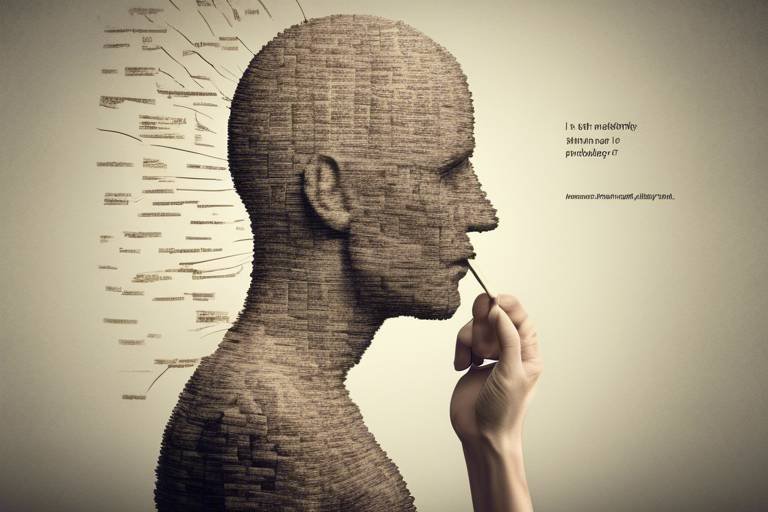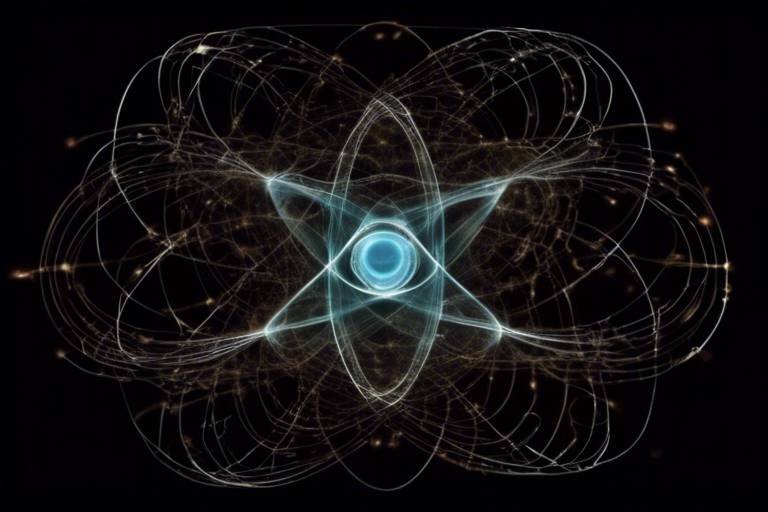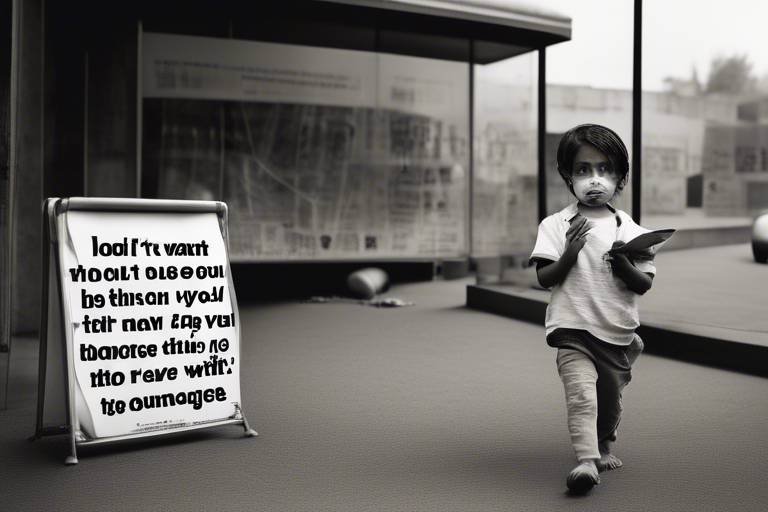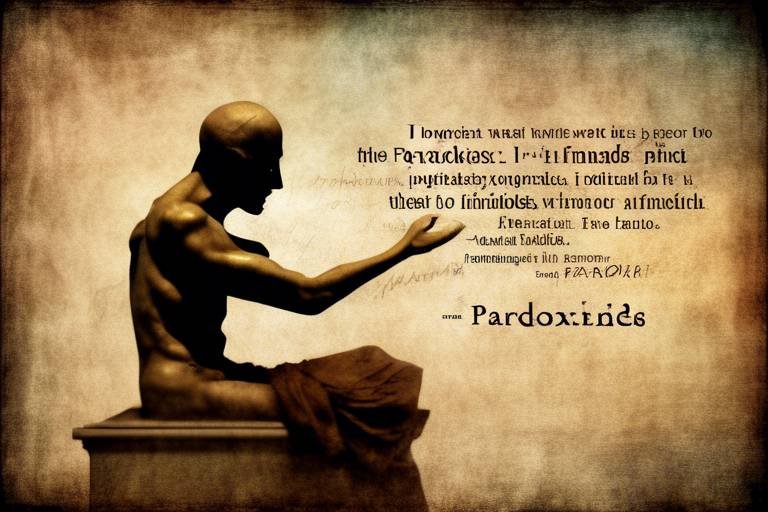Notion of Self in Eastern Philosophies
When we think about the self, we often picture a solid entity, a distinct personality that defines who we are. However, in the realm of Eastern philosophies, this notion takes on a fascinating twist. The exploration of self in Buddhism, Hinduism, and Taoism reveals a rich tapestry of ideas that challenge our conventional understanding. Rather than viewing the self as a fixed point, these philosophies encourage us to see it as a fluid and dynamic concept, shaped by various factors, including our thoughts, actions, and the universe around us.
Imagine for a moment that your identity is like a river, continuously flowing and changing course. In this analogy, the waters of your experiences, beliefs, and relationships shape the river's path, much like how the self is influenced by external and internal forces. This perspective invites us to reconsider our identity not as something static but as a vibrant and evolving process. As we delve deeper into the teachings of these Eastern philosophies, we will uncover how they interpret the self and its implications for personal identity and existence.
In Buddhism, the concept of Anatta, or non-self, fundamentally challenges the idea of a permanent self. It proposes that what we consider 'self' is merely an aggregation of experiences and perceptions, rather than a singular, unchanging essence. On the other hand, Hinduism presents a contrasting view through the lens of Atman, or the true self, which is seen as eternal and connected to the universal Brahman. Meanwhile, Taoism introduces a fluid notion of self, emphasizing harmony with the Dao, the fundamental principle that underlies and unites all things. These varied interpretations not only enrich our understanding of identity but also offer profound insights into how we navigate our existence.
As we journey through these philosophies, we will explore the intricate relationships between self, identity, and the universe. From the cyclical nature of life and rebirth in Hinduism to the interconnectedness emphasized in Taoism, the exploration of self in Eastern thought is both complex and enlightening. In the following sections, we will delve into each philosophy in detail, examining how they define the self and what that means for us in our modern lives.
- What is the main difference between Buddhism and Hinduism regarding the self?
Buddhism emphasizes Anatta, or non-self, suggesting that the self is an illusion, while Hinduism advocates for Atman, the true self that is eternal and unchanging. - How does Taoism view the self?
Taoism presents a fluid understanding of self, highlighting the interconnectedness of all things and the importance of harmony with the Dao. - What role does karma play in Hindu identity?
Karma influences one's identity by shaping experiences and consequences across lifetimes, affecting the notion of self and personal growth. - Can the teachings of Eastern philosophies apply to modern identity issues?
Yes, insights from these philosophies can inform contemporary discussions on identity, encouraging a more flexible and holistic understanding of self.

Buddhism and the Concept of Anatta
Buddhism introduces a profound and transformative idea known as Anatta, which translates to "non-self." At its core, Anatta challenges the conventional belief that we possess a permanent, unchanging self. Imagine for a moment that your identity is like a river—constantly flowing and changing, rather than a solid rock that remains fixed in place. This fluidity is a central tenet of Buddhist philosophy, emphasizing that what we perceive as 'self' is merely a collection of experiences, thoughts, and feelings that are in a state of perpetual flux.
The concept of Anatta is intricately linked to the Buddhist understanding of suffering and the path to enlightenment. According to Buddhist teachings, attachment to the idea of a permanent self leads to suffering. When we cling to our identities—our achievements, relationships, and even our thoughts—we inadvertently set ourselves up for pain. This is because everything is impermanent, and when the inevitable changes occur, we experience loss and distress. By embracing Anatta, practitioners are encouraged to let go of these attachments and, in turn, reduce their suffering.
In practical terms, how does one apply the concept of Anatta in daily life? Here are a few ways:
- Mindfulness Meditation: Practicing mindfulness helps individuals observe their thoughts and feelings without attachment, fostering a deeper understanding of the transient nature of self.
- Letting Go: By recognizing that identities are not fixed, individuals can learn to release their grip on labels and societal expectations.
- Compassion for Others: Understanding Anatta can lead to greater empathy, as we recognize that others, too, are navigating the complexities of identity and change.
This shift in perspective is not just a philosophical exercise; it has profound implications for personal identity and existence. By internalizing Anatta, individuals can cultivate a sense of freedom. Imagine shedding the weight of rigid self-definitions and stepping into a more expansive, interconnected existence. This is the essence of Buddhist practice—transforming the way we view ourselves and our place in the world.
Moreover, Anatta invites us to reconsider how we interact with others. If we acknowledge that everyone is undergoing their own journey of self-discovery, we can foster a deeper sense of connection and understanding. The teachings of Anatta encourage us to see beyond superficial differences and recognize the shared human experience of impermanence.
In summary, the concept of Anatta is not merely a philosophical abstraction; it is a practical guide for navigating life’s complexities. By embracing the fluid nature of self, individuals can find liberation from suffering and cultivate a more compassionate worldview. As we continue to explore the depths of Eastern philosophies, Anatta serves as a powerful reminder that our identities are not fixed but rather a dynamic interplay of experiences, ever-evolving and deeply interconnected.

Hinduism and Atman
In the rich tapestry of Hindu philosophy, the concept of Atman emerges as a cornerstone of understanding the self. Unlike the Buddhist notion of Anatta, which denies a permanent self, Hinduism embraces the idea of Atman as the eternal essence that exists within every individual. This essence is not just a fleeting identity but a profound connection to the universal spirit, known as Brahman. To comprehend Atman is to embark on a journey of self-discovery that transcends the physical realm and delves into the very fabric of existence.
Atman is often described as the true self, the unchanging reality that underlies the myriad experiences of life. It is the part of us that remains constant, regardless of the chaos of the external world. Imagine a vast ocean, with waves constantly rising and falling; the waves represent our thoughts, emotions, and experiences, while the ocean itself symbolizes Atman—deep, unshakeable, and eternal. This analogy highlights how, despite the tumult of daily life, our true essence remains untouched.
Understanding Atman also involves recognizing its relationship with Brahman. In Hinduism, Brahman is the ultimate reality, the source of all that exists. The famous phrase "Tat Tvam Asi," meaning "That Thou Art," encapsulates this relationship, suggesting that the individual self (Atman) is fundamentally one with the universal self (Brahman). This realization is not just philosophical; it has profound implications for how we perceive ourselves and our place in the universe.
To further explore the implications of Atman in Hindu thought, we can examine three key aspects:
- Unity with Brahman: The realization that Atman and Brahman are one leads to a sense of interconnectedness with all beings.
- Spiritual Growth: Understanding Atman encourages individuals to seek spiritual growth and enlightenment, moving beyond the ego and material attachments.
- Personal Identity: Atman provides a framework for personal identity that transcends societal labels and roles, emphasizing intrinsic worth.
As we delve deeper into the concept of Atman, we also encounter the idea of Karma, which plays a crucial role in shaping one's identity in Hindu philosophy. Karma, the law of cause and effect, dictates that every action has consequences that ripple through time and space. This means that our understanding of self is not static; instead, it evolves based on our actions and choices across lifetimes. The interplay of Atman and Karma creates a dynamic understanding of identity, where the true self is continuously shaped by both past actions and present decisions.
In essence, the concept of Atman invites us to reflect on our true nature and encourages a journey toward self-realization. It challenges us to look beyond the superficial layers of identity—such as name, occupation, and social status—and to connect with the deeper, unchanging essence that resides within. This journey is not just about personal enlightenment; it is about understanding our interconnectedness with all life, fostering compassion, and embracing the unity of existence.

The Role of Karma in Self-Identity
Karma, a term that resonates deeply within Hindu philosophy, plays a pivotal role in shaping one's self-identity. At its core, karma refers to the law of cause and effect, where every action has a corresponding reaction. This principle isn't just about moral judgments; it's about understanding how our choices and behaviors weave the fabric of our personal identity over time. Imagine your life as a tapestry, with each thread representing a decision you've made. Some threads are vibrant and joyful, while others may be dark and heavy, but together they create the unique picture of who you are.
In Hindu thought, karma extends beyond a single lifetime. It suggests that our actions today will influence not only our current existence but also our future incarnations. This cyclical nature of karma means that individuals are continuously evolving, shaped by their past deeds. For instance, if someone acts with kindness and compassion, they are likely to cultivate positive experiences in their future lives. Conversely, negative actions can lead to challenges and suffering, creating a complex interplay between self-identity and moral responsibility.
Furthermore, the concept of karma encourages individuals to reflect on their actions and their motivations. It prompts a deeper understanding of oneself, as one begins to see how their choices resonate within the larger universe. This reflection can lead to profound personal growth. By understanding the impact of karma, individuals can strive to make more conscious choices that align with their true self. It’s like being the author of your own story; every decision you make contributes to the plot, shaping your character along the way.
Here’s a simple breakdown of how karma influences self-identity:
| Karma Type | Impact on Self-Identity |
|---|---|
| Positive Karma | Fosters growth, happiness, and fulfillment in life. |
| Negative Karma | Leads to challenges and learning opportunities, promoting resilience. |
| Neutral Karma | Encourages self-reflection and awareness of one's actions. |
This dynamic relationship between karma and identity is also evident in the concept of dharma, or duty. Each person's dharma is unique, shaped by their circumstances, relationships, and past actions. By fulfilling one's dharma, individuals contribute positively to their karma, further refining their self-identity. It’s a beautiful cycle of growth, responsibility, and transformation.
Ultimately, the role of karma in self-identity is a reminder that we are not static beings. Instead, we are constantly in flux, influenced by our choices, experiences, and the interconnectedness of all life. Understanding this can empower individuals to take charge of their lives, consciously shaping their identities through mindful actions. So, the next time you make a choice, think about the threads you're weaving into your tapestry. What story do you want to tell?
- What is karma? Karma is the law of cause and effect, where every action has consequences that can affect future lives.
- How does karma influence identity? Karma shapes personal identity by linking actions to experiences across lifetimes, fostering growth and self-awareness.
- Can negative karma be changed? Yes, individuals can change their karma by making positive choices and fulfilling their dharma.
- What is dharma? Dharma refers to an individual's duty or purpose in life, which is influenced by their past actions and circumstances.

Reincarnation and the Self
Reincarnation, a cornerstone of Hindu belief, adds a fascinating dimension to the understanding of the self. Imagine life as a grand tapestry, woven with countless threads of experiences, actions, and lessons. Each thread represents a lifetime, and as we journey through these lives, we accumulate wisdom and insights that contribute to our evolving identity. In this context, the self is not a static entity but a dynamic and fluid concept, continuously shaped by past experiences and future possibilities.
This cyclical process of birth, death, and rebirth, known as samsara, is essential in comprehending how individuals perceive themselves. The self is not merely an isolated phenomenon; rather, it is intertwined with the universe and the collective consciousness of all beings. Each reincarnation offers a unique opportunity for growth and transformation, allowing individuals to learn from their past actions and make better choices in subsequent lives.
In Hindu philosophy, the essence of the self, or Atman, transcends the physical body. It is believed that while our bodies may perish, the Atman continues its journey through the cycle of reincarnation. This idea can be both comforting and daunting. On one hand, it encourages individuals to reflect on their actions, knowing that every deed contributes to their future selves. On the other hand, it raises questions about responsibility and the impact of one's choices across lifetimes.
Furthermore, the concept of reincarnation emphasizes the importance of karma, the principle of cause and effect. Each action generates a reaction, shaping not only the current life but also influencing future incarnations. For instance, if someone acts with compassion and kindness, they are likely to experience positive outcomes in this life and the next. Conversely, negative actions may lead to challenging circumstances in future existences. This interconnectedness of actions and consequences reinforces the idea that the self is not just an individual entity but part of a larger cosmic framework.
As we contemplate the relationship between reincarnation and the self, we can draw parallels to the idea of a river. Just as a river flows continuously, adapting to its surroundings while maintaining its essence, our selves flow through different lifetimes, shaped by experiences yet retaining a core identity. This fluidity invites us to embrace change and growth, recognizing that who we are today is a culmination of all our past selves.
In conclusion, reincarnation enriches our understanding of the self in Hindu philosophy by framing it as an ongoing journey of self-discovery and evolution. It teaches us that our identities are not fixed but are constantly shaped by our actions, choices, and the lessons we learn along the way. By embracing this concept, we can foster a deeper appreciation for the interconnectedness of all beings and the profound impact of our existence on the world around us.

Self-Realization and Moksha
The journey towards self-realization is a pivotal theme in Hindu philosophy, intricately tied to the concept of Moksha, or liberation. Imagine standing at the edge of a vast ocean, each wave representing a different aspect of your identity—your thoughts, emotions, and experiences. Now, picture diving deep into those waters, exploring the depths to discover the true essence of who you are. This is what self-realization is all about: peeling back the layers of illusion to reveal the eternal self, or Atman.
In Hinduism, self-realization is not merely an intellectual exercise; it is a profound transformation that leads to the understanding that the individual self (Atman) is fundamentally one with the universal consciousness (Brahman). This realization is akin to waking up from a dream, where the boundaries that once seemed so solid dissolve into the infinite. When one attains this understanding, they experience a profound sense of peace and unity with all existence.
Achieving Moksha is often depicted as the ultimate goal of life, representing freedom from the cycle of birth and rebirth (samsara). This liberation is not simply an escape from the physical realm; it is a deep, spiritual release that comes when one recognizes their true nature. To illustrate, consider the metaphor of a butterfly emerging from its cocoon. The struggle to break free is essential, as it symbolizes the journey of self-discovery and enlightenment. Only by embracing this transformation can one truly soar into the realm of Moksha.
There are several paths to self-realization and ultimately Moksha, including:
- Jnana Yoga: The path of knowledge, where one engages in deep contemplation and study of sacred texts to understand the nature of reality.
- Bhakti Yoga: The path of devotion, where love and surrender to a personal deity lead to a deeper connection with the divine.
- Karma Yoga: The path of selfless action, emphasizing the importance of performing one’s duties without attachment to the results.
Each of these paths offers unique insights and practices, but they all converge on the same destination: the realization of the self's true nature. As practitioners delve into these teachings, they often find that the journey itself is as significant as the destination. The process of questioning, reflecting, and experiencing life with an open heart fosters a deeper connection to oneself and the universe.
In summary, the concepts of self-realization and Moksha are not merely philosophical ideas but practical tools for living a more fulfilling life. By understanding and embracing these teachings, individuals can navigate their personal journeys with greater clarity and purpose, ultimately leading to liberation from the confines of the ego and a joyful reunion with the divine essence that permeates all existence.
1. What is self-realization in Hindu philosophy?
Self-realization refers to the awakening of one's true self (Atman) and understanding its unity with the universal consciousness (Brahman).
2. How does one achieve Moksha?
Moksha is achieved through various paths such as Jnana Yoga, Bhakti Yoga, and Karma Yoga, which facilitate the understanding and realization of the true self.
3. Is self-realization a one-time event?
No, self-realization is often seen as a continuous journey of growth and understanding, where insights deepen over time.
4. Can anyone achieve Moksha?
Yes, according to Hindu philosophy, anyone can achieve Moksha through sincere effort, dedication, and the right practices tailored to their unique path.

Daoism and the Fluid Self
Daoism, often recognized for its profound connection to nature and the universe, presents a unique perspective on the concept of self. Unlike the rigid definitions found in many Western philosophies, Daoism embraces a more fluid and dynamic understanding of identity. In this view, the self is not a fixed entity but rather a constantly evolving process influenced by the Dao, which can be understood as the fundamental principle that underlies and unites all things in existence.
At the heart of Daoism lies the idea of wu wei, or effortless action. This principle encourages individuals to align themselves with the natural flow of the universe, suggesting that true selfhood emerges not from striving or forcing one’s will upon the world, but rather from embracing spontaneity and allowing life to unfold organically. In this context, the self is not an isolated island but a part of a larger ocean, interconnected with all other beings and phenomena. Just as a river flows and changes shape with the landscape, so too does the self adapt and transform in response to its surroundings.
Moreover, Daoism emphasizes the importance of harmony and balance in one’s life. The concept of yin and yang illustrates this beautifully, representing the dualities that exist within and outside of us. The self, in Daoist thought, is a dance of these opposing forces, constantly seeking equilibrium. This perspective allows individuals to understand that their identity is not a singular, static label but a complex interplay of various influences and experiences. Just as day turns to night, and summer gives way to winter, our identities shift and evolve over time, shaped by our interactions with the world around us.
Additionally, the idea of the fluid self in Daoism can be likened to the concept of water. Water is adaptable, taking the shape of whatever vessel contains it, yet it remains fundamentally water. This metaphor illustrates how individuals can maintain their core essence while being flexible and responsive to change. By embracing this fluidity, one can navigate the complexities of life with grace and resilience, fostering a deeper understanding of oneself in relation to the cosmos.
In summary, Daoism invites us to reconsider our notions of self by presenting an identity that is interconnected, dynamic, and adaptable. By recognizing our place within the greater tapestry of existence, we can cultivate a sense of peace and harmony, ultimately leading to a more fulfilling and authentic life.

Comparative Analysis of Eastern Philosophies
When diving into the rich tapestry of Eastern philosophies, one cannot help but notice the intricate threads that weave together the notions of self in Buddhism, Hinduism, and Daoism. Each tradition offers a unique perspective, akin to viewing a multifaceted gemstone where each facet reflects a different light. While Buddhism emphasizes the concept of Anatta or non-self, suggesting that the self is an illusion, Hinduism counters with the idea of Atman, the eternal true self that connects to the universal Brahman. Daoism introduces a fluid understanding of self, promoting harmony with the ever-changing nature of the Dao. Together, these philosophies create a complex dialogue about identity and existence.
To better understand these differences and similarities, let’s break down some key aspects:
| Aspect | Buddhism | Hinduism | Daoism |
|---|---|---|---|
| Concept of Self | Anatta (non-self) | Atman (true self) | Fluid self |
| Ultimate Reality | Nirvana (cessation of suffering) | Brahman (universal consciousness) | Dao (the way) |
| Identity Formation | Through the understanding of impermanence | Through the realization of Atman | Through alignment with the Dao |
This table encapsulates the essence of how each philosophy interprets the self and its relationship to the universe. The Buddhist view of Anatta teaches that clinging to a permanent self can lead to suffering. In contrast, Hinduism's Atman suggests that realizing one's true self is essential for spiritual liberation. Daoism, on the other hand, encourages individuals to embrace the fluidity of existence and adapt to the natural rhythms of life.
Moreover, the implications of these philosophies extend beyond theoretical discussions. They invite individuals to reflect on their own identities and life experiences. For instance, consider how the Buddhist path encourages mindfulness and the recognition of impermanence. This practice can lead to a profound transformation in how one perceives personal identity, fostering a sense of freedom from attachment. Similarly, the Hindu pursuit of Moksha through self-realization offers a pathway to understanding one's place in the universe, while Daoism teaches the importance of living in harmony with nature, suggesting that the self is not separate from the world around us.
In a world that often emphasizes individualism, these Eastern philosophies remind us of the interconnectedness of all beings. They challenge us to rethink our definitions of self and identity, prompting questions such as: Are we merely products of our experiences, or is there a deeper essence that defines us? This inquiry can lead to a richer understanding of not only ourselves but also our relationships with others and the universe.
- What is the main difference between Anatta and Atman? Anatta refers to the Buddhist concept of non-self, suggesting that there is no permanent, unchanging self, while Atman in Hinduism is considered the true, eternal self that connects to Brahman.
- How does Daoism view the self? Daoism presents a fluid notion of self, emphasizing harmony with the Dao and the interconnectedness of all life.
- Can these philosophies coexist in modern life? Absolutely! Many people find value in integrating aspects of these philosophies into their understanding of identity and existence, promoting a more holistic view of self.

Implications for Modern Identity
The exploration of self in Eastern philosophies offers a treasure trove of insights that resonate deeply with contemporary discussions on identity. In a world that often feels fragmented and chaotic, the teachings of Buddhism, Hinduism, and Daoism provide a refreshing perspective that can help us navigate our personal and collective identities. For instance, the Buddhist concept of Anatta, or non-self, challenges us to reconsider the permanence we often associate with our identities. Instead of clinging to a fixed notion of who we are, we can embrace the idea that our identities are fluid and ever-changing, shaped by our experiences and interactions.
Similarly, Hinduism's concept of Atman invites us to delve deeper into our true selves, encouraging us to look beyond the surface of our identities. This journey of self-discovery can be incredibly empowering, as it allows us to connect with a greater universal essence, the Brahman. In this light, our individual identities are not isolated but are part of a larger tapestry of existence. This understanding can foster a sense of belonging and interconnectedness, which is particularly vital in today’s globalized society where cultural boundaries are increasingly blurred.
Moreover, the principles of Karma remind us that our actions have consequences that extend beyond our immediate lives. This perspective encourages personal responsibility and mindfulness, urging us to reflect on how our choices shape not only our identities but also the world around us. Imagine if we all adopted this mindset—how different would our interactions and relationships be? By acknowledging that our actions contribute to a larger narrative, we can cultivate a more compassionate and empathetic society.
Daoism adds another layer to this conversation by emphasizing the fluidity of self. The Dao teaches us that identity is not a rigid construct but rather a dynamic interplay of forces. This perspective encourages us to adapt and flow with life’s changes, promoting resilience in the face of adversity. By understanding ourselves as part of a greater whole, we can better navigate the complexities of modern life, finding harmony amid chaos.
Ultimately, the implications of these ancient philosophies for modern identity are profound. They challenge us to break free from limiting beliefs about who we are and to embrace a more expansive view of self. This shift can lead to greater self-acceptance, emotional well-being, and a deeper connection with others. As we integrate these teachings into our lives, we may find ourselves not only redefining our identities but also enriching our relationships and enhancing our overall sense of purpose.
- How can Eastern philosophies help with modern mental health issues?
Eastern philosophies promote mindfulness and self-awareness, which can significantly improve mental health by reducing anxiety and fostering a sense of peace. - What is the significance of understanding Anatta in daily life?
Understanding Anatta can help reduce attachment to a fixed identity, allowing for more flexibility and adaptability in life. - How does the concept of Karma influence modern ethical considerations?
Karma encourages individuals to consider the broader impact of their actions, promoting a more responsible and ethical approach to living.
Frequently Asked Questions
- What is the concept of Anatta in Buddhism?
Anatta, or non-self, is a fundamental principle in Buddhism that suggests there is no permanent, unchanging self. Instead, it teaches that our identity is a collection of changing experiences and perceptions. This perspective encourages practitioners to let go of attachments to a fixed identity, leading to greater freedom and understanding.
- How does Hinduism define Atman?
In Hinduism, Atman refers to the true self, which is eternal and unchanging. It is considered a part of the universal Brahman, the ultimate reality. Understanding Atman is crucial for realizing one's identity beyond the physical body and mind, and it plays a significant role in the spiritual journey towards liberation.
- What role does karma play in shaping identity in Hindu philosophy?
Karma, the law of cause and effect, is essential in Hinduism as it determines the circumstances of one's life and future rebirths. Each action influences the soul's journey, shaping personal identity across different lifetimes. This interconnectedness of actions and consequences highlights the dynamic nature of self.
- How does reincarnation affect the understanding of self in Hinduism?
Reincarnation introduces the idea that the self is not limited to a single lifetime. Instead, it emphasizes a continuous journey of growth and evolution. Each rebirth offers opportunities for learning and self-realization, impacting how individuals perceive their identity and purpose in life.
- What is Moksha and its significance in Hindu thought?
Moksha is the ultimate goal in Hindu philosophy, representing liberation from the cycle of birth and rebirth. Achieving Moksha involves realizing the true nature of Atman and its unity with Brahman. This profound understanding leads to freedom from suffering and a deep sense of peace and fulfillment.
- What does Daoism say about the self?
Daoism presents a fluid and interconnected view of the self, suggesting that personal identity is shaped by the Dao, or the natural way of the universe. This philosophy encourages individuals to embrace change and harmony, fostering a sense of unity with all aspects of life.
- How do Eastern philosophies compare in their views on self?
Eastern philosophies like Buddhism, Hinduism, and Daoism offer unique perspectives on self. While Buddhism emphasizes non-self and the impermanence of identity, Hinduism focuses on the eternal Atman and the journey towards Moksha. Daoism, on the other hand, highlights the fluidity of self and the importance of harmony with the universe, creating a rich tapestry of understanding personal identity.
- What implications do these philosophies have for modern identity discussions?
The insights from Eastern philosophies provide valuable perspectives for contemporary discussions on identity. They challenge rigid notions of self and encourage individuals to explore their identities as dynamic and interconnected. By integrating these teachings, people can cultivate a deeper understanding of themselves and their place in the world.



















